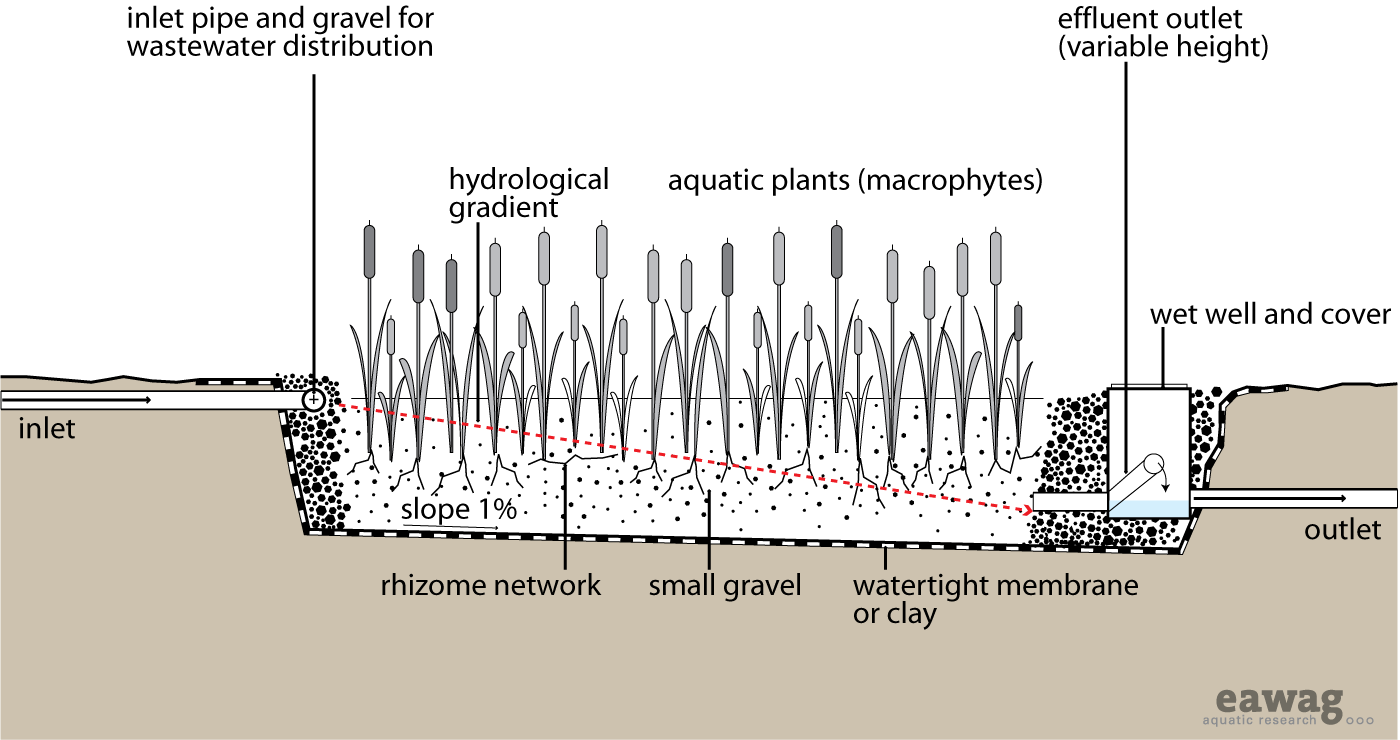Horizontal Subsurface Flow Constructed Wetland
|
|||||||||||||||||||||||||||
A Horizontal Subsurface Flow Constructed Wetland is a large gravel and sand-filled channel that is planted with aquatic vegetation. As wastewater flows horizontally through the channel, the filtermaterial filters out particles and microorganisms degrade organics.
The water level in a Horizontal Subsurface Flow Constructed Wetland is maintained at 5 to 15cm below the surface to ensure subsurface flow. The bed should be wide and shallow so that the flow path of the water is maximized. A wide inlet zone should be used to evenly distribute the flow. Pre-treatment is essential to prevent clogging and ensure efficient treatment.
The bed should be lined with an impermeable liner (clay or geotextile) to prevent leaching. Small, round, evenly sized gravel (3–32mm in diameter) is most commonly used to fill the bed to a depth of 0.5 to 1m. To limit clogging, the gravel should be clean and free of fines. Sand is also acceptable, but is more prone to clogging. In recent years, alternative filter materials such as PET have been successfully used.
The removal efficiency of the wetland is a function of the surface area (length multiplied by width), while the cross-sectional area (width multiplied by depth) determines the maximum possible flow. A well-designed inlet that allows for even distribution is important to prevent short-circuiting. The outlet should be variable so that the water surface can be adjusted to optimize treatment performance.
The filter media acts as both a filter for removing solids, a fixed surface upon which bacteria can attach, and a base for the vegetation. Although facultative and anaerobic bacteria degrade most organics, the vegetation transfers a small amount of oxygen to the root zone so that aerobic bacteria can colonize the area and degrade organics as well. The plant roots play an important role in maintaining the permeability of the filter.
Any plant with deep, wide roots that can grow in the wet, nutrient-rich environment is appropriate. Phragmites australis (reed) is a common choice because it forms horizontal rhizomes that penetrate the entire filter depth.
Pathogen removal is accomplished by natural decay, predation by higher organisms, and sedimentation.
| Advantages | Disadvantages/limitations |
|---|---|
| - Requires less space than a Free-Water Surface Constructed Wetland. - High reduction in BOD, suspended solids and pathogens. - Does not have the mosquito problems of the Free-Water Surface Constructed Wetland. - Can be built and repaired with locally available materials. - Construction can provide short-term employment to local labourers. - No electrical energy required. |
- Requires expert design and supervision. - Moderate capital cost depending on land, liner, fill, etc.; low operating costs. - Pre-treatment is required to prevent clogging. |
Contents
Adequacy
Clogging is a common problem and therefore the influent should be well settled with primary treatment before flowing into the wetland. This technology is not appropriate for untreated domestic waste water (i.e. blackwater). This is a good treatment for communities that have primary treatment (e.g. Septic Tanks or WSPs) but are looking to achieve a higher quality effluent. This is a good option where land is cheap and available, although the wetland will require maintenance for the duration of its life.
Depending on the volume of water, and therefore the size, this type of wetland can be appropriate for small sections of urban areas, peri-urban and rural communities. They can also be designed for single households.
Horizontal Subsurface Flow Constructed Wetlands are best suited for warm climates but they can be designed to tolerate some freezing and periods of low biological activity.
Health Aspects/Acceptance
The risk of mosquito breeding is reduced since there is no standing water compared to the risk associated with Free-Water Surface Constructed Wetlands. The wetland is aesthetically pleasing and can be integrated into wild areas or parklands.
Maintenance
With time, the gravel will clog with accumulated solids and bacterial film. The filter material will require replacement every 8 to 15 or more years. Maintenance activities should focus on ensuring that primary treatment is effective at reducing the concentration of solids in the wastewater before it enters the wetland. Maintenance should also ensure that trees do not grow in the area as the roots can harm the liner.
Acknowledgements
The material on this page was adapted from:
Elizabeth Tilley, Lukas Ulrich, Christoph Lüthi, Philippe Reymond and Christian Zurbrügg (2014). Compendium of Sanitation Systems and Technologies, published by Sandec, the Department of Water and Sanitation in Developing Countries of Eawag, the Swiss Federal Institute of Aquatic Science and Technology, Dübendorf, Switzerland.
The 2nd edition publication is available in English. French and Spanish are yet to come.
References and external links
- Crites, R. and Tchobanoglous, G. (1998). Small and Decentralized Wastewater Management Systems. WCB and McGraw-Hill, New York, USA. pp 599–609. (Comprehensive summary chapter including solved problems.)
- Mara, DD. (2003). Domestic wastewater treatment in developing countries. Earthscan, London. pp 85–187.
- Poh-Eng, L. and Polprasert, C. (1998). Constructed Wetlands for Wastewater Treatment and Resource Recovery. Environmental Sanitation Information Center, AIT, Bangkok, Thailand.
- Polprasert, C., et al. (2001). Wastewater Treatment II, Natural Systems for Wastewater Management. Lectur Notes, IHE Delft, The Netherlands. Chapter 6.
- Reed, SC. (1993). Subsurface Flow Constructed Wetlands For Wastewater Treatment, A Technology Assessment. United States Environmental Protection Agency, USA. Available: http://www.epa.gov (Comprehensive design manual.)


